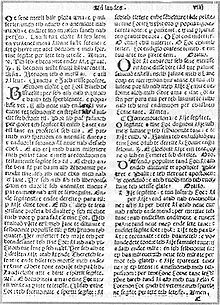Gjon Buzuku
Gjon Buzuku | |
|---|---|
Catholic priest | |
| Notable work | Meshari |
| Parent |
|
| Family | Buzuku |
Gjon Buzuku (c. 1499 – c. 1577) was an Albanian
Life
Very little that is known about Gjon Buzuku comes from the last page of his book, where he mentions being the son of a certain Bdek (Benedict) Buzuku. In the same text he also informs about his service as a priest in a church not far away from where the printers workshop was located. Most scholars agree that this was in Venice.
From March 20, 1554, to January 5, 1555, he wrote a translation of the Catholic
I, John, son of Benedict Buzuku, having often considered that our language had in it nothing intelligible from the Holy Scriptures, wished for the sake of our people to attempt, as far as I was able, to enlighten the minds of those who understand, so that they may comprehend how great and powerful and forgiving our Lord is to those who love him with all their hearts. I beg of you from today on to go to church more often to hear the word of God.
Based from the Albanian dialect used, it is obvious that Buzuku came from a
The first Albanian book

Considered to be the oldest published book in Albanian, Meshari was discovered in 1740 by Gjon Nikollë Kazazi, the archbishop of Skopje. In other libraries there are three photocopies from the original, one of them in Tirana. In 1996, the librarians were not able to locate the book, which had been used in 1984 for the last time. Eqrem Çabej wrote a monograph on the book in 1968. The dialect used in Meshari was one of the main subjects of Selman Riza's works.[3]
The place the book was printed is thought to be either Venice or Shkodër. Though recent studies by Lucia Nadin give convincing evidence that make Venice as the place where Meshari was printed.,[4] According to Nadin, it was at the workshop of Bernardino Bindoni that this might have happened. Another hypothesis is that it was printed at the workshop of the Scotto family in Venice.
The book contains the liturgies of the main
, and many illustrations.The orthography is peculiar. The Latin alphabet with some additional letters is used. The consequent character of orthography and grammar seems to indicate an earlier tradition of writing.
In Albanian, the book is known as Meshari (The Missal). All we know about the author is from the book's
Sources
- ^ Monica Genesin / Joachim Matzinger (2021). 4 Old Albanian, Comparison and Gradation in Indo-European,
- ^ Yll Rugova (2022). Një Gjon Buzuk nga Friuli, doktorant në Padovë në vitin 1567, ExLibris, Tirana
- ISBN 978-3-05-003652-6. Retrieved 8 July 2011.
- ^ Franco Tagliarini (2013). Albania ritrovata di Lucia Nadin, Albania Letteraria, 29 Aprile 2013
